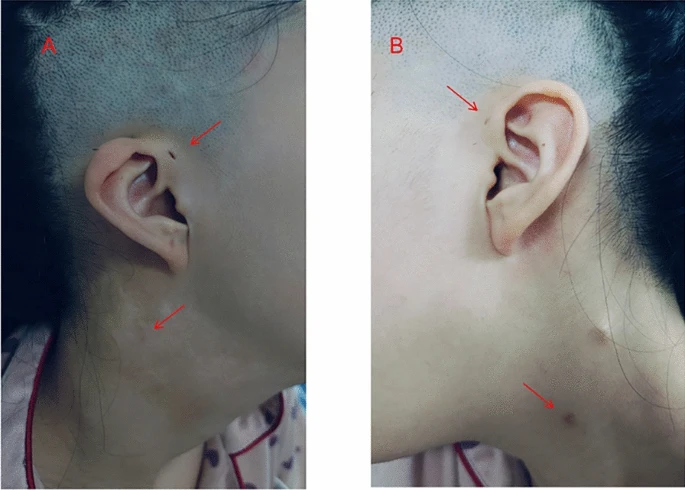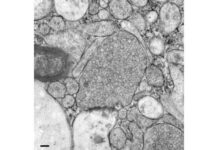Case Report
Branchio-oto-renal syndrome (BORS) is a rare autosomal dominant condition. It affects around 1/40,000 of the general population and 2% of children with substantial hearing loss. It is distinguishable by branchial cleft anomalies (fistulas or cysts), hearing loss, preauricular pits, and kidney deformities. BORS’s clinical manifestations involve numerous systems and are highly heterogeneous, making diagnosis difficult.
To confirm BORS, the following parameters are: no family history, at least three primary criteria, or two primary and two secondary criteria. Having a family history and meeting one of the primary criteria is enough to diagnose. The main criteria were second branchial abnormalities, hearing loss, preauricular pits, and renal anomaly. Minor criteria included external, middle, and inner ear anomalies, preauricular tags, facial asymmetry, and palate abnormalities.
This case introduces a patient with BORS, and provide insights that will help in the diagnosis and management of similar instances in the future.
Case Presentation
A 20-year-old Han Chinese female reported to the Department of Otorhinolaryngology, Head, and Neck Surgery with bilateral preauricular and lateral neck fistulas that had been present since birth. The fistulas intermittently released foul-smelling fluid. The patient was aware that he had no major hearing loss and was developing normal speech.
Physical examination reveals that the patient has normal intelligence, cup-shaped deformity in the right ear, normal appearance in the left auricle. She also has small fistulas in front of both ears, unobstructed external auditory canals on both sides, intact eardrums on both sides, and clear markings. A fistula was at the anterior edge of the middle segment of the bilateral sternocleidomastoid muscles, with scar tissue surrounding the fistula on the right side.
A strip-like tissue was palpated beneath the skin. And a small amount of mucous-like discharge squirted from the surrounding skin.
Investigation
Auxiliary exam: pure tone audiometry revealed bilateral sensorineural hearing loss. The average hearing threshold of the right ear airway was 35 dBnHL. While, the average for the left ear airway was 45 dBnHL. The temporal bone computed tomography (CT) and magnetic resonance imaging (MRI) showed enlarged left vestibular aqueduct. MRI revealed bilateral branchial fistulas. Abdominal ultrasonography revealed a modest volume of the left kidney. Normal renal function (creatinine 72.0 μmol/L and eGFR 103.48 mL/min). The patient was born into a nonconsanguineous marriage, with neither parent having a similar medical history.
After preoperative tests, bilateral preauricular and bilateral branchial fistulotomies the final conclusion was BORS. The fistula was stained intraoperatively with methylene blue. Half a year after surgery, the patient’s incision completely healed with no discharge.
Discussion
BORS is a rare autosomal dominant genetic condition with significant clinical heterogeneity. And the penetrance rate varies greatly even within a single family. Research has demonstrated that BORS exhibits hearing loss, gill abnormalities, preauricular depression, and kidney abnormalities.
In addition to the classic clinical signs of the ears, gills, and kidneys noted above. Many investigations have reported other BORS-related symptoms such as developmental delay, intellectual incapacity, hypospadias, and bone deformities. The most prevalent symptom of BORS is hearing loss, which affects 64-100% of individuals. Mixed hearing loss is the most common kind of hearing loss in patients with BORS, followed by sensorineural and conductive hearing losses.
Imaging investigations have revealed that structural anomalies in the inner/middle ear, such as an underdeveloped cochlea. And an expanded vestibular aqueduct. Imaging investigations can show abnormalities in the inner and/or middle ear of BORS patients. Cochlear hypoplasia is the most prevalent inner ear defect, followed by vestibular aqueduct enlargement and inner ear canal anomalies.
The patient had bilateral branchial fistula, preauricular fistula, auricular malformation. A massive vestibular aqueduct, and left renal dysplasia, all of which met the BORS diagnostic criteria. For this patient, both fistulas were excised independently to preserve the anatomical structure while lowering the likelihood of fistula recurrence. There is no cure for BORS in patients with sensorineural hearing loss. However, hearing aids can be used as an adjuvant treatment.




